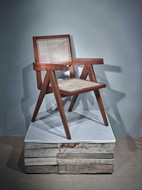STRUCTURAL FEATURES: Designed by Swiss architect and designer of furniture Pierre Jeanneret during his stay in Chandigarh in the 1950s, the Cross Easy Chair is an example of the sculptural albeit elegant furniture of the Modernist period in postcolonial India. The chair is designed during this period, along with a host of other furniture for the city’s administrative buildings. The sleek structure of the chair – slightly elevated armrests, a cane backrest and seat, and sharp, inverted V-shaped legs -- is manifest of a strong western Modernist design with a colonial touch. Jeanneret worked on furniture design independently as well as with Corbusier. His way of working involved experimentation, and in his own words, was “always a bit anarchic”.
STYLISTIC FEATURES: The humble, minimal design of the chair involves braided cane-work and is absent of any embellished features. The armrests and legs are structured at sharp, well-defined angles, and the seat is expansive enough to lend comfort to the sitter.



CROSS EASY CHAIR
DESIGNER: Pierre Jeanneret
MATERIAL: Wood, cane
STYLISTIC INFLUENCE: Modern
DESIGNER: Pierre Jeanneret
MATERIAL: Wood, cane
STYLISTIC INFLUENCE: Modern

